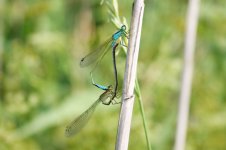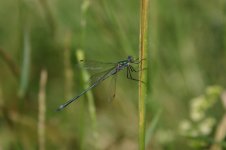
Okay, a couple more that have been puzzling me ...
Picture one - photographed Blue-tailed Damselfly already and thought they were easy, then photographed these and they stumped me for a while. Previous ones had been rufesens females and quite different and had not noticed the greenness of the eyes as in this one, but after quite a while scratching my head, I have concluded this is an infuscans female. Any confirmation?
Picture two - Lestes sponsa (Emerald Damselfly) or Lestes dryas (Scarce Emerald Damselfly)? I lean towards sponsa on pterostigma
Picture one - photographed Blue-tailed Damselfly already and thought they were easy, then photographed these and they stumped me for a while. Previous ones had been rufesens females and quite different and had not noticed the greenness of the eyes as in this one, but after quite a while scratching my head, I have concluded this is an infuscans female. Any confirmation?
Picture two - Lestes sponsa (Emerald Damselfly) or Lestes dryas (Scarce Emerald Damselfly)? I lean towards sponsa on pterostigma





